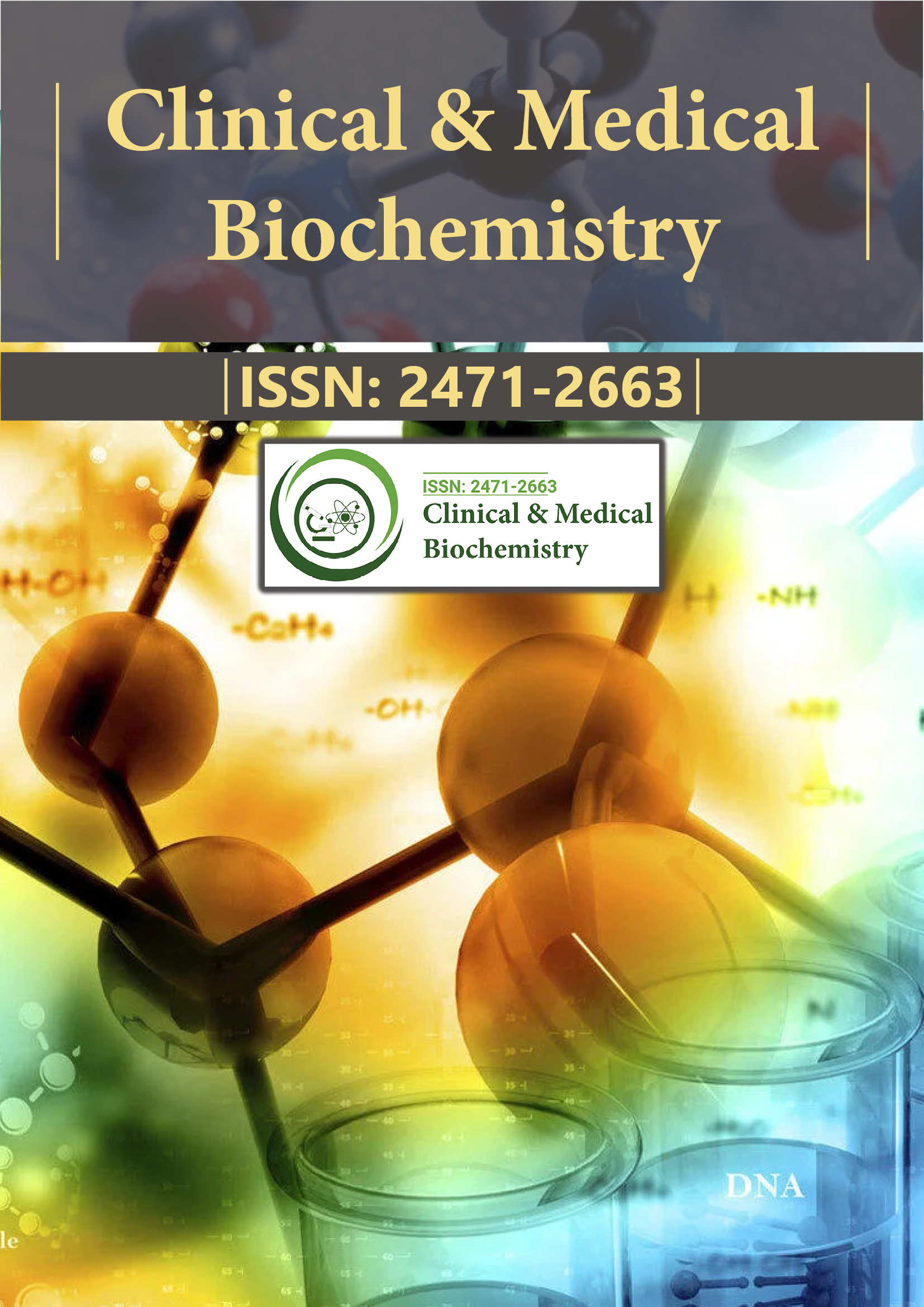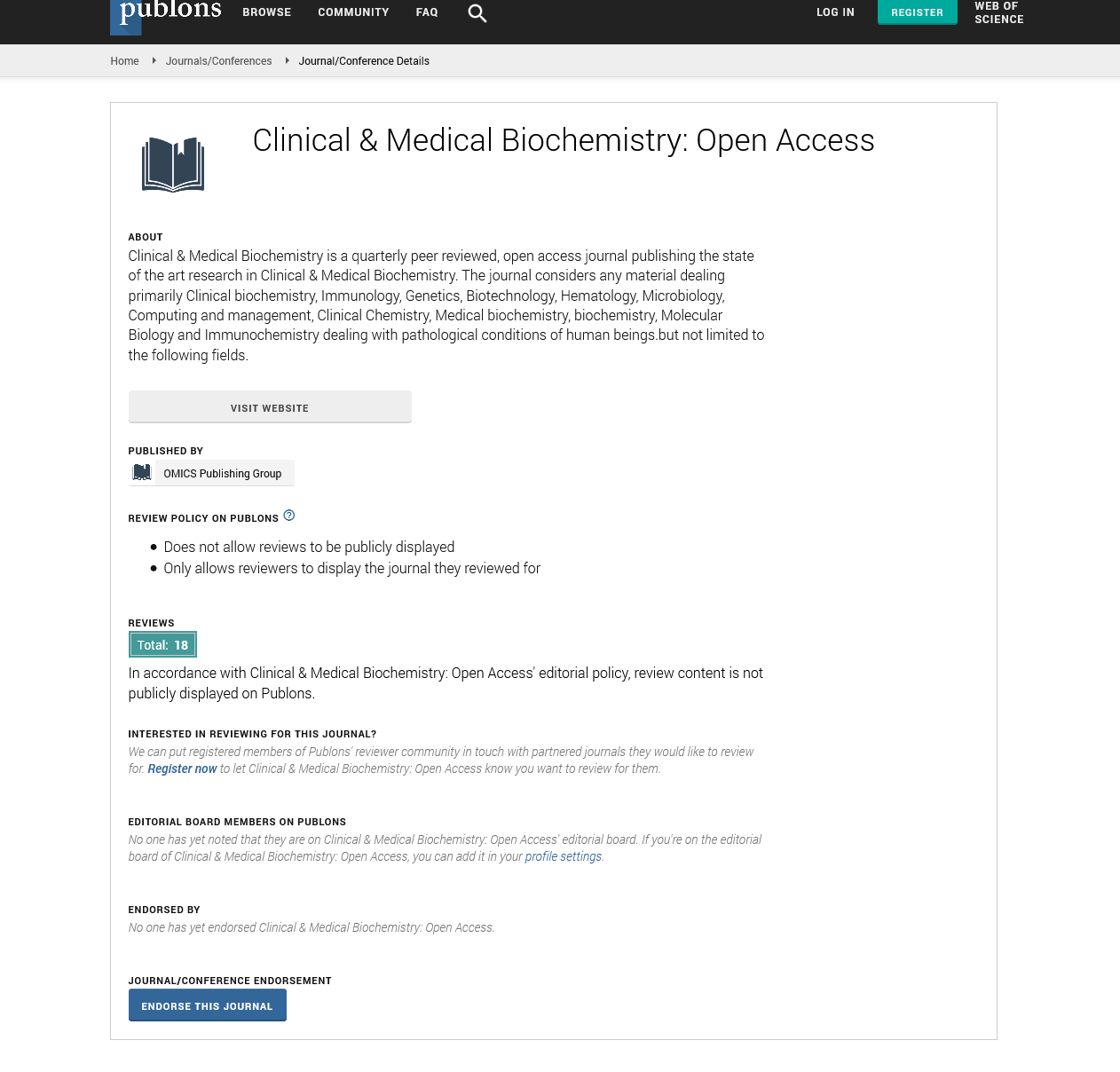Indexed In
- RefSeek
- Directory of Research Journal Indexing (DRJI)
- Hamdard University
- EBSCO A-Z
- OCLC- WorldCat
- Scholarsteer
- Publons
- Euro Pub
- Google Scholar
Useful Links
Share This Page
Journal Flyer

Open Access Journals
- Agri and Aquaculture
- Biochemistry
- Bioinformatics & Systems Biology
- Business & Management
- Chemistry
- Clinical Sciences
- Engineering
- Food & Nutrition
- General Science
- Genetics & Molecular Biology
- Immunology & Microbiology
- Medical Sciences
- Neuroscience & Psychology
- Nursing & Health Care
- Pharmaceutical Sciences
Short Communication - (2023) Volume 9, Issue 2
Effects of Adiponectin a Protein Hormone in Cell Proliferation and its Role in Obesity
Kenneth Lanpo*Received: 03-Mar-2023, Manuscript No. CMBO-23-20528; Editor assigned: 06-Mar-2023, Pre QC No. CMBO-23-20528 (PQ); Reviewed: 20-Mar-2023, QC No. CMBO-23-20528; Revised: 27-Mar-2023, Manuscript No. CMBO-23-20528 (R); Published: 03-Apr-2023, DOI: 10.35841/2471-2663.23.9.153
Description
Adipocyte complement-related protein of 30 kDa (Acrp30), another name for adiponectin, was discovered by many research teams. The adipokine adiponectin, which is generated and secreted in large amounts by adipose tissues, is well known for its anti-diabetic, anti-inflammatory, anti-atherogenic, and cardioprotective properties. Adiponectin is a 244 amino acid protein hormone that circulates in high concentrations (5 g/ mL -30 g/mL) and makes up 0.01% of the total proteins in serum. Pigs, rats, and fat humans all had lower serum and adiponectin expression levels. The monomeric peptide sequence consists of an amino-terminal peptide, a short hypervariable region, a collagen-like domain with 22 Gly-XPro or Gly-X-Y repeats, and a carboxy-terminal globular domain C1q-like [1]. The monomeric form of adiponectin, known as fAdiponectin, or the protein's globular form, are both seen in serum (gAdiponectin). The proteolytic cleavage product of fAdiponectin, known as gAdiponectin, includes the globular head without the collagen-like domain, allowing trimers but not (High Molecular Weight) amyloid HMW oligomers to form. Recent research has shown that the monomeric form boosts peripheral glucose uptake, fatty acid oxidation, and AMPK activation in muscle. Additionally, an increase in gAdiponectin has been linked to improved wholebody energy metabolism and adipose tissue functioning [2].
The hydroxylation and glycosylation of four conserved lysine residues (lys65, lys68, lys77, and lys101) and/or the hydroxylation of proline residues inside the collagenous domain are the most significant modifications to adiponectin in humans. The assembly of human adiponectin oligomers also rely on the disulfide bond formation, which is mostly mediated by cysteine 39. Moreover, after secretion, certain adiponectin complexes do not interconvert. Adiponectin homooligomer construction of different molecular weights is an important process that is intimately linked to the biological functions of this adipokine. It is well recognised that low levels of HMW oligomers are a separate risk factor for metabolic pathologies including obesity-related disorders and that they are the main significant forms of adiponectin in insulin sensitivity activities [3]. For these reasons, the HMW/total adiponectin ratio appears to be more helpful than total adiponectin in determining the risk of a number of diseases, such as obesity, Insulin Resistance (IR), type 2 diabetes (T2DM), Metabolic Syndrome (MetS), and Cardiovascular Diseases (CVDs) Adiponectin is encoded by the APM1 gene (adipose most abundant gene transcript1), which consists of three exons spanning 16 kb. APM1 is found in the 3q27 area on the long arm of chromosome 3, which has been linked to several Quantitative Trait Loci (QTL) for MetS and T2DM. Adiponectin has recently been identified as interfering with several cancer cell types, including breast, endometrial, colon, stomach, prostate, and leukaemia, in in vitro investigations [4]. In reality, adiponectin slows cell proliferation and triggers apoptosis through many molecular mechanisms, both in vitro and in vivo.
Adiponectin prevents carcinogenesis via p21 and p53, which control growth arrest and apoptosis in colon cancer cells. This is done by stimulating AMPK. Moreover, in lung and pancreatic cell lines, the tumor-suppressing properties of adiponectin are mediated by AKT and ERK signalling pathways. Numerous different investigations have, however, also raised the possibility that adiponectin has a proliferative and antiapoptotic function. With some exceptions, epidemiologic studies have shown links between decreasing adiponectin levels and the emergence of cancer. Adiponectin levels are really lower in people with breast and endometrial cancer, but they are higher in people with lung, prostate, gastric, liver, pancreatic, haematological, colon, and renal cancer. Obesity is a significant health issue that raises the risk of MetS, CVDs, respiratory conditions, diabetic retinopathy, and cancer [5]. By an aberrant production of adipokines, visceral body fat in obese patients may have an impact on health issues. Adiponectin is crucial to energy metabolism; total adiponectin and HMW concentrations fall in obesity and rise following weight loss. Its levels increase along with a specific rise in the HMW oligomers, which are the most physiologically active, following weight loss. Adiponectin expression was associated with genetic variations in metabolic illnesses, such as T2DM and obesity. For instance, low levels of total adiponectin and HMW oligomers in patients with these disorders are strongly associated with the mutations p.G48R, P.Y111H, p.R112C, and p.G90S. There are also 12 SNPs in the adiponectin gene (APM1), some of which and their associated haplotypes are linked to hypoadiponectinemia, IR, and a higher risk of T2DM.
References
- Yang J, Park OJ, Kim J, Han S, Yang Y, Yun CH, et al. Adiponectin deficiency triggers bone loss by up-regulation of osteoclastogenesis and down-regulation of osteoblastogenesis. Front Endocrinol. 2019;10:815.
[Crossref ] [Google Scholar] [PubMed]
- Choi HM, Doss HM, Kim KS. Multifaceted physiological roles of adiponectin in inflammation and diseases. Int J Mol Sci. 2020;21(4):1219.
[Crossref ] [Google Scholar] [PubMed]
- Zhou Y, Yang Y, Zhou T, Li B, Wang Z. Adiponectin and thyroid cancer: insight into the association between adiponectin and obesity. Aging Dis. 2021;12(2):597.
[Crossref ] [Google Scholar] [PubMed]
- Ilia I, Nitusca D, Marian C. Adiponectin in Osteoarthritis: Pathophysiology, Relationship with Obesity and Presumptive Diagnostic Biomarker Potential. Diagnostics. 2022;12(2):455.
[Crossref ] [Google Scholar] [PubMed]
- Łączna M, Kopytko P, Tkacz M, Zgutka K, Czerewaty M, Tarnowski M, et al. Adiponectin Is a Component of the Inflammatory Cascade in Rheumatoid Arthritis. J Clin Med. 2022;11(10):2740.
[Crossref ] [Google Scholar] [PubMed]
Citation: Lanpo K (2023) Effects of Adiponectin a Protein Hormone in Cell Proliferation and its Role in Obesity. Clin Med Bio Chem. 9:153.
Copyright: © 2023 Lanpo K. This is an open-access article distributed under the terms of the Creative Commons Attribution License, which permits unrestricted use, distribution, and reproduction in any medium, provided the original author and source are credited.

